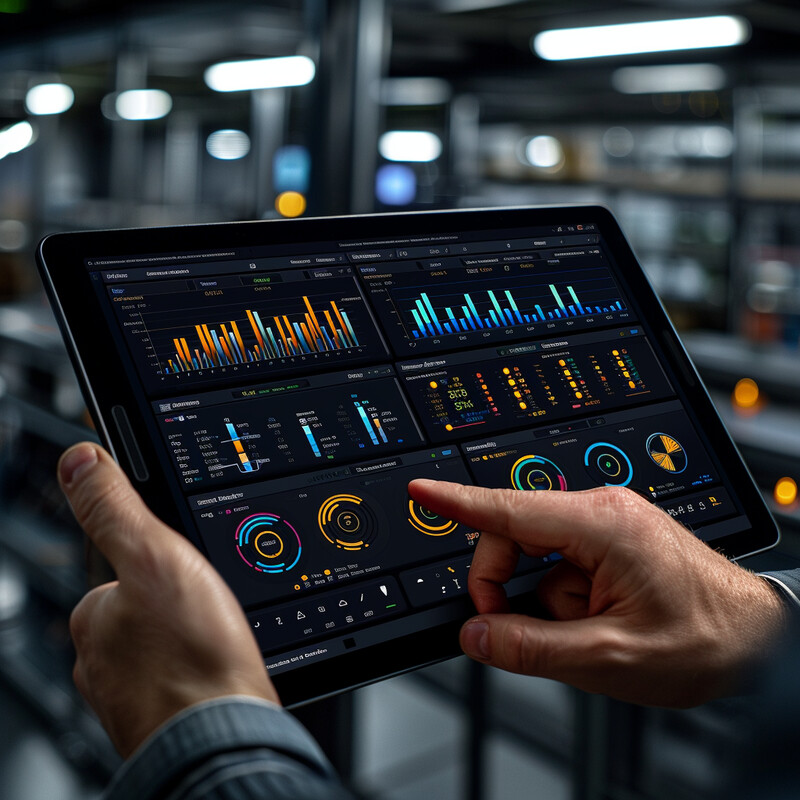1. Demand Forecasting
AI-driven demand forecasting analyzes large volumes of historical sales data, market trends, and even external factors (like weather or holidays) to predict future product demand with greater accuracy. By identifying patterns that humans might miss, AI can forecast which products will be popular and in what quantity. This helps retailers optimize inventory levels – keeping enough stock of high-demand items while avoiding overstock of slow sellers. The result is fewer stockouts (empty shelves) and less excess inventory, leading to cost savings and improved customer satisfaction. In essence, AI makes demand planning more precise, enabling retailers to meet customer needs without tying up too much capital in inventory.

Research by McKinsey & Company found that applying AI to supply chain forecasting can reduce forecast errors by 20–50%. This improved accuracy translated into up to a 65% reduction in lost sales from stockouts, as stores were less likely to run out of products that shoppers wanted. In addition, companies saw related benefits like lower warehousing costs and leaner inventory levels when using AI-driven forecasting models. Such results demonstrate how AI-based demand forecasting directly improves inventory availability and efficiency in retail.
2. Automated Replenishment
AI enables automated inventory replenishment by monitoring stock levels in real time and triggering orders or alerts when items run low. Instead of relying on employees to manually reorder products, an AI system can track sales and inventory 24/7 across stores and warehouses. When it detects that stock for a particular item is below a set threshold, it can automatically initiate a reorder from the supplier or transfer from a warehouse. This ensures shelves are restocked promptly and consistently. Automated replenishment reduces the chance of human error or delayed reorders, so popular products don’t go out of stock. It also frees up staff time, as employees spend less effort on routine inventory checks and can focus on other tasks. Overall, AI-driven replenishment keeps product availability high and the replenishment process efficient.

Major retailers are investing in AI to keep shelves stocked. For example, Walmart piloted an AI-based shelf monitoring system using computer vision cameras in 70 Canadian stores, which automatically detected low-stock situations and triggered restocking alerts. After a successful trial, Walmart expanded this AI replenishment technology to all of its Canadian locations. In the U.S., Walmart is also deploying electronic shelf labels and AI systems chain-wide to streamline restocking across 4,600 stores, aiming to improve productivity and ensure products are always available for both in-store and online orders. These implementations show how AI is being used at scale to automate and accelerate inventory replenishment in retail.
3. Price Optimization
AI plays a critical role in dynamic pricing and price optimization for retail. By analyzing data on demand, inventory levels, competitor prices, and customer behavior, AI algorithms can recommend the optimal price for each product at any given time. This means retailers can adjust prices in real time – for instance, lowering prices to clear out excess stock or raising prices slightly when an item is in high demand and stock is limited. Such AI-driven pricing strategies aim to maximize revenue and profitability while still remaining attractive to consumers. They also help prevent markdown waste by avoiding situations where large quantities of stock have to be heavily discounted later. In short, AI enables a more responsive and data-driven approach to pricing, continually finding the balance between sales volume and profit margin.

A recent analysis by Boston Consulting Group reported that retailers using AI-powered dynamic pricing models saw significant financial benefits. Companies that adopted AI for pricing increased their gross profit by about 5–10% on average, while also sustainably boosting overall revenue and maintaining strong customer value perception. These retailers could react quickly to market changes – for example, adjusting prices during peak demand – in ways that improved margins without alienating customers. The study underscores that AI-driven price optimization helps retailers capture more profit and sales growth compared to traditional one-size-fits-all pricing strategies.
4. Supplier Performance Analysis
AI helps retailers evaluate and manage their suppliers by analyzing various performance metrics. This can include data on delivery timeliness (are shipments arriving on schedule?), product quality (defect or return rates), order accuracy, and compliance with contracts. By processing all this information, AI systems can score or rank suppliers based on their reliability and performance. Retail managers get a clearer picture of which suppliers consistently meet expectations and which ones tend to cause issues (like late deliveries or frequent product problems). With these insights, retailers can make more informed decisions – for instance, allocating more orders to high-performing suppliers or working with underperforming suppliers to improve. AI can even predict potential supply chain disruptions by flagging unusual patterns (like a usually reliable supplier starting to ship late). Ultimately, AI-driven supplier analysis leads to a more resilient supply chain with fewer surprises, since retailers can proactively address supplier issues and choose partners based on data-driven performance evaluations.

Studies indicate that AI can dramatically speed up supplier evaluation and selection. According to McKinsey research, modern AI tools are able to reduce the time needed to identify suitable suppliers by over 90%. Instead of procurement teams manually sifting through supplier records and market data for weeks, an AI system can instantly analyze vast databases – including suppliers’ delivery histories, financial stability indicators, and even news or social media sentiment – to shortlist the best candidates. This acceleration in supplier analysis helps retailers react faster when they need to find new or backup suppliers, strengthening the supply chain. It also means ongoing performance monitoring can be continuous, with AI flagging risks (like a supplier experiencing delays) in real time so that retailers can respond before small issues become big problems.
5. Product Placement Optimization
In physical retail stores, where and how products are displayed can greatly influence sales – and AI is helping optimize these decisions. By utilizing data from in-store sensors, shopper traffic patterns, and sales figures, AI systems can determine the ideal placement for products on shelves and store layouts. For example, AI might analyze which aisles get the most foot traffic and suggest placing high-margin or popular items in those areas to increase visibility. It can also test different product arrangements (virtually) to predict which setup will lead to more impulse buys or better product discovery by customers. Additionally, AI can personalize store layouts at a local level – for instance, if one store’s data shows that a certain community buys much more of Product A than average, the system might recommend giving Product A more shelf space or a prime location in that store. By continually learning from sales and movement data, AI keeps refining placement strategies. The outcome is a store layout that is data-driven to guide shoppers to items they want (or didn’t know they wanted), enhancing the shopping experience and boosting sales.

Consulting firm Bain & Company has documented substantial gains from data-driven product placement and “perfect store” initiatives. Their analysis of consumer goods companies found that leveraging advanced analytics (including AI) to optimize in-store execution led to sales growth of over 5% within the first year of implementation. This approach, termed “Perfect Store” by Bain, involves using granular data to ensure the right products are in the right places in each store, with proper shelf space and positioning. The result is improved visibility for key items and an overall lift in sales. Such metrics underscore that AI-informed product placement and retail execution aren’t just theoretical – they tangibly increase revenue by making stores more effective at converting shopper interest into purchases.
6. Loss Prevention
AI is increasingly used in retail loss prevention to combat theft and fraud, which are major sources of profit loss (known as “shrinkage”). Traditional security cameras and audits produce a lot of data; AI can monitor these feeds and transaction logs in real time to spot anomalies that indicate theft. For instance, AI-powered video analytics can recognize if someone conceals an item or if a cashier fails to scan an item at checkout. Similarly, AI can analyze point-of-sale transactions to flag patterns like multiple refunds or voided sales that might suggest internal fraud. By catching these red flags early (often as they happen), AI enables security or management to intervene immediately, preventing losses. Some stores also employ AI-driven sensors (like smart shelf tags or RFID) that alert if high-value items are removed without being paid for. In summary, AI acts as vigilant, always-on surveillance and analytics for retail operations, helping reduce shoplifting, cashier errors, and fraudulent returns – all of which translates to preserving inventory and revenue that would otherwise be lost.

Retail theft and other forms of shrinkage have become a nearly $100 billion per year problem for the industry. In response, many retailers are deploying AI solutions to protect their inventory. These include smart camera systems that use computer vision and machine learning to identify suspicious behavior in stores, as well as AI analytics at self-checkouts to catch scanning fraud. According to reporting from the National Retail Federation’s 2022 security survey, retailers are leveraging tools like video analytics, RFID “heat maps,” and autonomous security robots to deter and detect theft in real time. Early adopters of AI in loss prevention have reported reductions in shrink, as the technology can instantly flag potential theft incidents (for example, a camera noticing someone pocketing an item) so that staff can respond before the thief exits the store. By augmenting human security with AI’s speed and pattern recognition, stores can significantly cut down losses from shoplifting and fraud.
7. Waste Reduction in Perishables
Grocers and retailers dealing with perishable goods (like food, produce, and other items with expiration dates) use AI to minimize waste from spoilage. AI can forecast demand for perishable items more accurately, so stores stock the right amounts and timing of fresh products – preventing large unsold surpluses that go bad. It can also track products’ shelf life in real time. For example, sensors and AI might monitor the temperature and age of items like dairy or meat; if something is nearing its expiration, the system could recommend discounting it or moving it to a store location where it’s more likely to sell quickly. Additionally, AI might dynamically adjust pricing or promotions for perishables based on how fast they’re selling versus how soon they’ll spoil (sometimes called “dynamic markdowns” for nearing-expiry goods). By proactively managing stock levels and pricing of fresh items, AI helps ensure more of the inventory is sold to customers rather than thrown away. This not only recoups revenue that would be lost in the trash bin but also has sustainability benefits by reducing food waste.

AI solutions have proven effective in cutting food waste. In 2022, a pilot program under the Pacific Coast Food Waste Commitment had two large grocery retailers implement AI-driven inventory and ordering systems (from providers Shelf Engine and Afresh). The result was a 14.8% average reduction in food waste per store during the trial. Extrapolating from this success, analysts at ReFED (a food waste research nonprofit) estimate that if the entire grocery sector adopted similar AI tools, it could prevent about 907,000 tons of food waste, which equates to more than $2 billion in savings and significant environmental benefits. These figures demonstrate AI’s tangible impact: by optimizing ordering and stock of perishables, retailers keep more produce and fresh goods in the value chain (sold or donated) and out of landfills. Some companies have also used AI-based waste tracking cameras (e.g., the Winnow system) in their cafeterias and seen food waste cut in half, underscoring AI’s versatility in reducing waste from farm to table.
8. Customer Insights and Personalization
AI allows retailers to derive deep customer insights and personalize the shopping experience, which in turn influences stock management. By analyzing data from loyalty programs, past purchases, online browsing history, and even social media, AI can identify trends and preferences among a retailer’s customer base. Retailers learn which products are popular with which customer segments and can tailor their inventory assortment at each store accordingly (stocking more of what local customers prefer). On the marketing side, AI enables personalized recommendations and promotions – for example, an AI system might suggest products to a customer based on their buying history (“customers who bought X also buy Y”) or send targeted offers that are likely to appeal to that individual. This personalization improves the customer’s experience (making it more likely they find what they want) and can increase sales of certain stock. Additionally, by predicting customer demand on a granular level, AI helps retailers ensure the right products are in the right place. Overall, AI turns masses of customer data into actionable strategies for inventory selection and individualized marketing, leading to a more customer-centric retail experience.

Retailers have rapidly embraced AI for personalization in recent years. In a 2023 survey, 71% of U.S. retail decision-makers said they have invested in data/AI-driven content personalization for customers. These investments are yielding results: over three-quarters (77%) of the retailers who implemented AI personalization reported moderate or significant increases in their online sales performance as a direct outcome. One key driver is product recommendations powered by AI – for example, Amazon’s well-known recommendation engine (which McKinsey estimates drives 35% of Amazon’s sales) uses AI to tailor suggestions to each shopper. Similarly, many brick-and-mortar chains use AI to analyze local buying patterns so that each store’s assortment matches neighborhood tastes (a form of personalization in merchandising). The data shows that AI-fueled personalization not only enhances customer satisfaction but also boosts sales and conversion rates, making it a top priority in modern retail strategies.
9. Returns Management
Handling product returns efficiently is a growing challenge in retail, and AI is helping optimize this process. AI can analyze patterns in returns to identify common causes – for instance, if a particular clothing item is frequently returned due to sizing issues, the retailer might adjust the product description or sizing chart. Predictive models can forecast return rates for certain products or categories, which helps with inventory planning (knowing that, say, 10% of a batch will likely come back). AI is also used to decide the best disposition of a returned item: based on condition and demand, the system might recommend whether to put it back on shelf, refurbish it, discount it, or recycle it. Additionally, AI-driven fraud detection is crucial in returns management – the system can flag suspicious return behavior (like serial returners or returns of used items) so that retailers can intervene or tighten policies for those cases. By streamlining the returns handling, AI reduces the cost and labor associated with returns, speeds up refund or exchange processes for legitimate customers, and recovers more value from returned stock. In essence, AI helps retailers turn returns from a pure cost center into a more manageable, even insightful, part of the business.

Retail returns have ballooned with the rise of e-commerce, reaching an estimated $685 billion in merchandise (13.2% of total U.S. retail sales) in 2024. Within that, fraudulent and abusive returns (for example, returning worn or stolen items) accounted for over $100 billion in losses in 2024. To combat these trends, retailers are using AI-based solutions in returns management. For instance, AI algorithms can analyze return transactions and customer return histories to flag 15% of returns that are potentially fraudulent, enabling retailers to intercept those. The CEO of Appriss Retail (a returns analytics firm) noted that an “AI-powered, data-driven approach” to returns is effective at reducing fraud and improving customer loyalty simultaneously. On the customer service side, some retailers have implemented AI chatbots to guide customers through the returns process or even to offer alternatives (like troubleshooting a product issue to avoid a return). Overall, these applications of AI are helping retailers handle high volumes of returns more cost-effectively – by quickly sorting genuine returns from shady ones, and by gleaning insights to reduce future return rates (such as improving product information or quality).
10. Integrated Omnichannel Experience
AI is a key enabler of the integrated omnichannel retail experience, where online and offline channels blend seamlessly. One challenge of omnichannel retail is keeping inventory in sync – a customer should be able to see on a website if a local store has an item in stock for pickup, for example. AI helps by constantly reconciling inventory data across warehouses, physical stores, and online marketplaces in real time. This ensures that if an item sells in-store, the online system immediately reflects the lower stock (preventing overselling something that’s actually gone). AI can also make smart fulfillment decisions in an omnichannel setup: when an online order comes in, AI determines whether it’s best to ship from a warehouse, from a store, or arrange in-store pickup, based on inventory and location, thus delivering faster and more efficiently. From the shopper’s perspective, AI contributes to features like personalized online recommendations with the option to pick up in store, or an app that guides you to a product’s location inside the store. Essentially, AI knits together the various retail channels – mobile app, website, brick-and-mortar, even social media shops – so that customers experience them as one unified store. This leads to more convenience (buy anywhere, fulfill anywhere) and often higher sales, as customers who engage on multiple channels tend to buy more.

Omnichannel shopping is now common consumer behavior, and retailers rely on AI to support it. Recent statistics show that 67% of U.S. consumers have used “buy online, pick up in store” (BOPIS) or other click-and-collect services in their shopping journey. Moreover, omnichannel customers are valuable – studies by Harvard Business Review found they spend 4% more in-store and 10% more online on average than single-channel shoppers (due to greater engagement across platforms). To facilitate this, retailers use AI to synchronize inventories and orders across channels in real time, ensuring that if a customer places an online order for store pickup, the product is indeed set aside and ready. In 2023, about 78% of major North American retailers offered click-and-collect options, which typically depend on AI-driven systems to coordinate online sales with in-store stock. By investing in these AI-powered omnichannel platforms, retailers are catering to how modern customers shop – hopping between online and physical – and providing a smooth, integrated experience (for example, seamless e-commerce sites, accurate stock info, and rapid fulfillment choices) that meets rising expectations.